Ranching On Prairie Creek 1946-1964
Narrative by Roger W. Hockett
NOTE: Some of the photos herein are from online sources as many ranch photos have been lost
Birth at Grandfather Dr. CT Hockett’s Hospital in Enterprise
As I understand it I was born in the old Wallowa County Hospital in Enterprise that had been founded by my grandfather Dr. C.T. Hockett (who bought the old Enterprise High School building and converted it, see photo). This was May 1st, 1946 and a few years later my brothers David and Clyde both had their tonsils taken out in the same building. I vaguely remember visiting them as they were coming down from “laughing gas” and eating ice cream. I have been told that Dad was out farming and could not make it in for my birth. Probably a wise economic choice

Around 1943 the original ranch house burnt to the ground.
David and Clyde beside The Old House
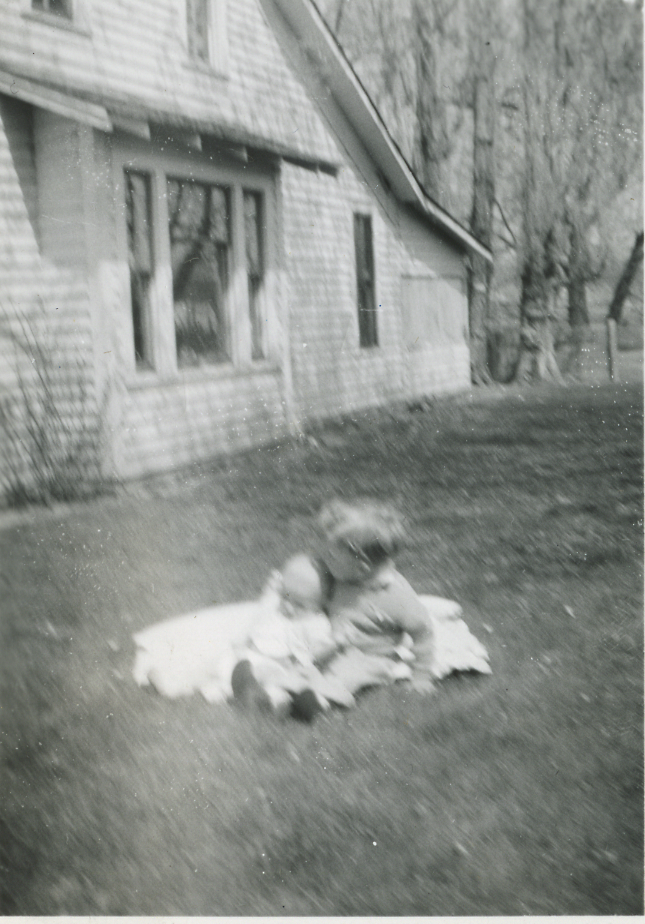
Early Years in the Old Bunk House
My first real memory is of us living (camping) in the Old Bunk House for hired men, which was behind the place where our original main house had been up until it burnt to the ground in the early Forties. The bunk house was simple, three rooms and one long rectangle probably 20′ x 50′: the North end where the kids bunk beds were at, had a blanket hanging across the opening; then the middle area with the kitchen and table; then the South end with a blanket divider where Mom and Dad slept. My fuzzy memories are of a cozy place with all of us living on top of each other and lots of coming and going. The parents probably thought it was bedlam.
The Bunk House (missing the garage on the right end, now at the Little House)
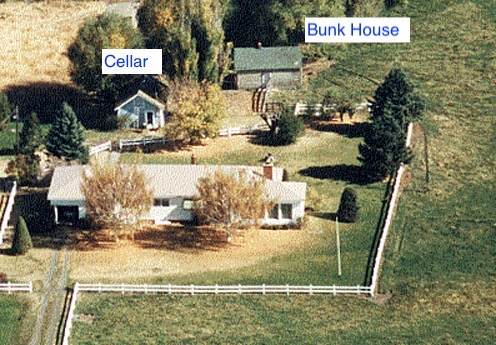
David, Clyde, Roger in Front of Bunk House
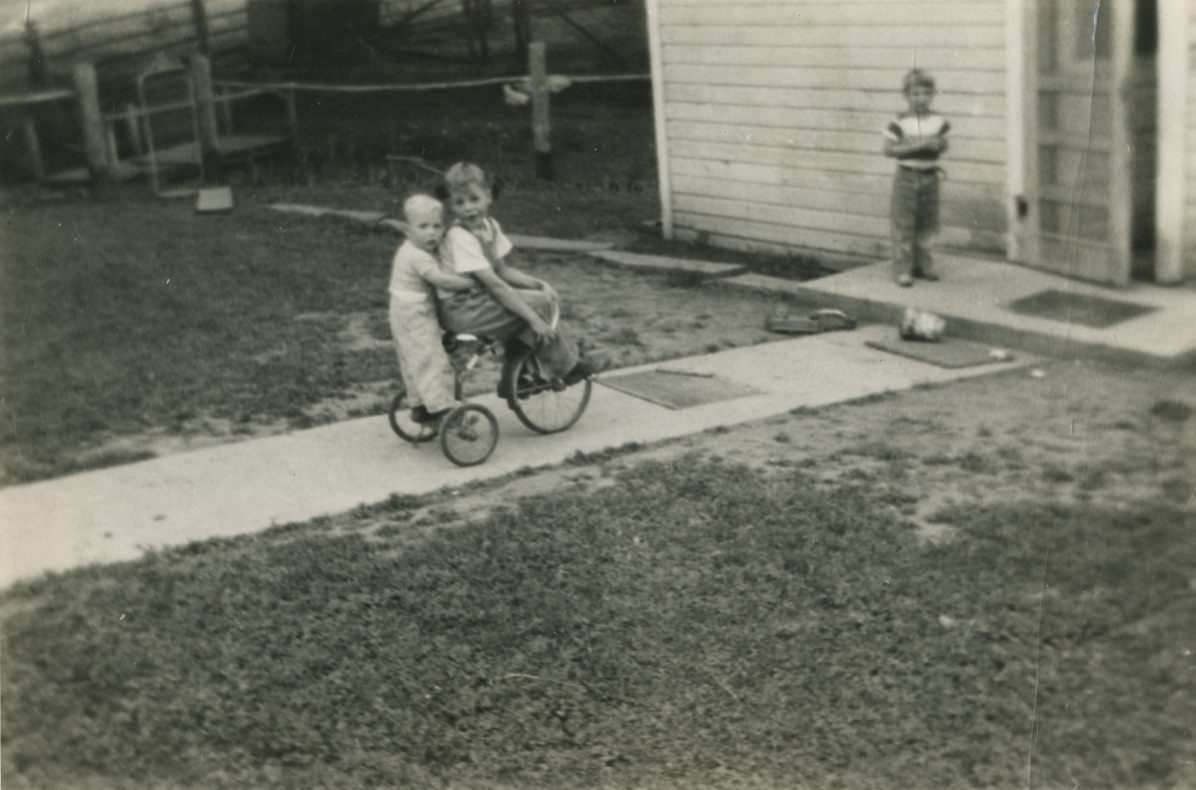
During this time, besides ranching and farming, the other main activity was building the New House on the site of the Old House. But first you have to clear the land. I have a very distinct memory of watching Dad and another man use dynamite to blow up all the tree stumps that used to be in front of the original house, next to the road. The trees were killed in the old house fire and the new house was going to be bigger so the stumps had to go. That was an exciting day filled with lots of noise and bursting visual effects. These kinds of memories last the longest in older minds.
Building The New House, 1950-51
My earliest memories of this period are wondering around the construction site of the new house and being shooed off by the carpenters. Back then you did not hire a construction company, you hired a couple of talented carpenters and they built your house.
Living next to the construction site for a new house is wonderful for a small child, lots to see and do, but worrisome for adults. The new house was to be one of the largest and nicest houses on any of the farms for miles around. I think that was the hard bargain my Mom drove with Dad to compensate her for giving up teaching and taking on a life of cooking for hay crews in the summers. This is also a good example of the prosperity that the County was feeling after the misery of the Depression and WWII. People were ready to start living a better life with modern appliances.
New House With Mom, Mid 1960’s
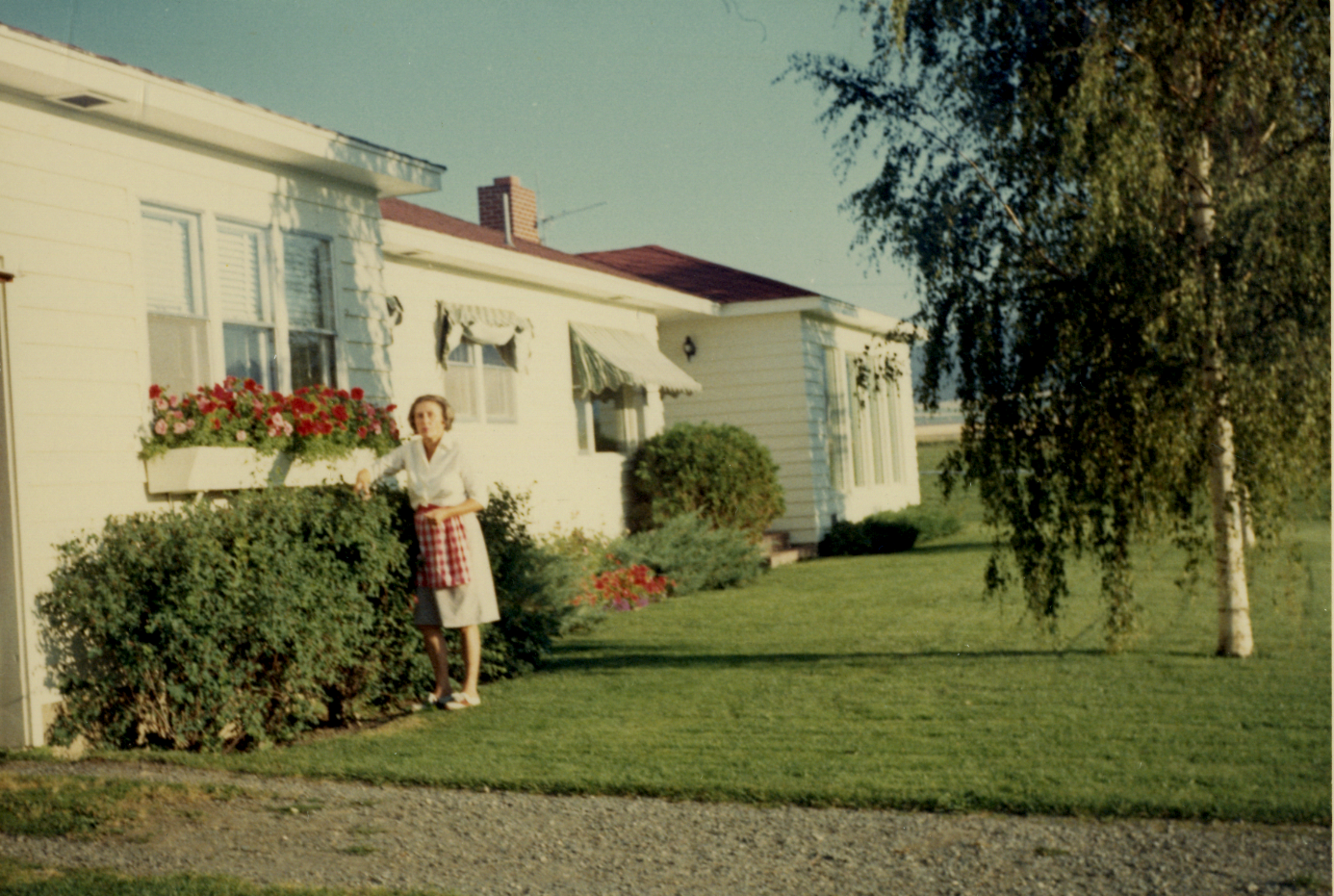
One of the events that happened during this was my getting a sunstroke. There was an area of left over gravel from construction behind the new house and it was a favorite play area. One summer day I went to sleep in the gravel pit and slept for over two hours in the direct sun and without a hat. When I woke up my head had a severe headache. I spent the next two weeks in bed with an ice pack on my head trying to alleviate the pain. This may have been the source of my life long migraines.
The Barnyard Buildings
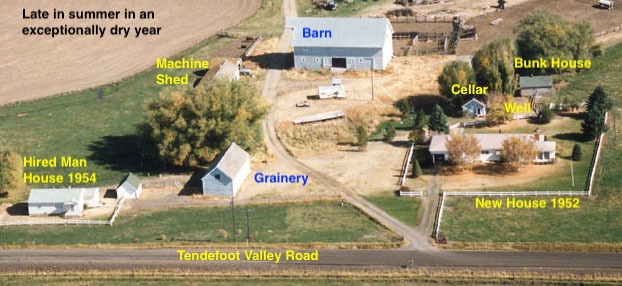
The New House was long with a large living room, formal dining room, kitchen with large eating area, utility room, bunk room for the kids, master bedroom and guest room plus 1-1/2 bathrooms. There was a full concrete basement (rare in those days) with a walk in cellar for storage (jars of canned fruits). During the long winter months (much colder with more snow at that time) the basement was a large, warm place to play, refinish our wood snow skis, play with our model railroad, and generally stay away from adults. Remember, no TV until 1958 and even then it was like watching a black and white snow storm.
The 1950’s On The Ranch
The Ranch sat at an elevation of 4,200 feet and was next to mountains that were snow capped ten months out of the year. The area is an interior climate, no mild winters here. This all means there were four very distinct seasons and life on the Ranch reflected those changing seasons, especially given that the occupation was farming and ranching.
Winter On The Ranch
The fifties was before global warming from climate change began to kick in. Many winters had temperatures down to 10 to 20 below zero at night. The average in December-January was probably around +5 to minus 10 degrees at night. Often snow drifts would reach the house roof eves after a windy storm passed through. There were always long icicles coming down from the gutters. Every morning we went around breaking the ice in the water troughs. The tractors had an electric element in the engine block keeping them warm overnight so the motor would turn over in the morning.
Winter In The Valley, Looking West
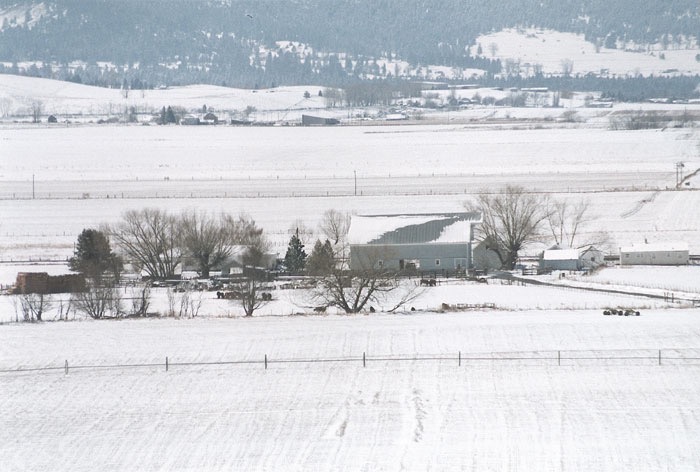
At 5:30 am in the dark, before getting ready for school, we would start up the tractor and pull the loaded hay wagon around the barn, toward the back pasture. As we approached the gate, the headlamps on the tractor would illuminate the area ahead and we could see the cattle all lined up on the other side of the gate, their frosty breath filling the air with a bawling greeting for us to hurry up.
Waiting To Be Fed
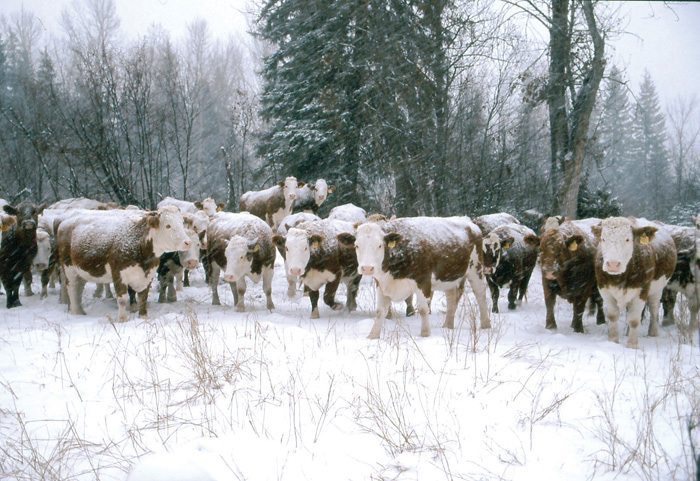
We would spend the next 45 minutes driving over the frozen field pitching the broken hay bales off the wagon for the hungry cattle trailing out behind us. One of us drove (usually me) and the other pitched the hay, this took about 45 minutes.
Eating Hay Tossed From Hay Wagon
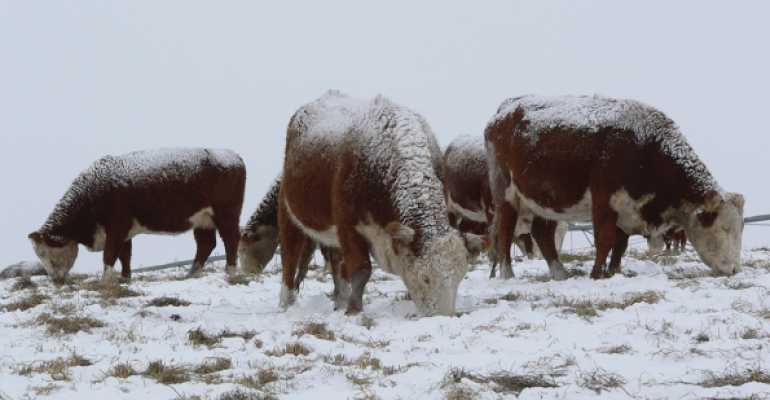
Besides breaking the ice and feeding the cattle, we also had to water and feed our 4-H steers, which were kept in the barn. If the wind was also blowing, then it was very cold and a pretty miserable time; we could not wait to finish our chores and head back for a hot breakfast and catch the school bus. While we were at school Dad would reload the hay wagon for the next day. This was the routine for 3 months in the winter.
Dairy Cows
In the fifties (before 1956) there was also the need to milk the dairy cows every morning and night. We had about 10-15 cows. After we drove the cows into the barn Dad was the one who performed the milking; we had mechanical milkers (a post WWII invention). We also had a cream separator in the cellar to refine some of the milk into cream and skim milk for our own use. Most of the rich milk was sold to the Raven Creamery in Enterprise. Our waste skim milk was fed to the hogs. Raven Creamery had a curing room holding 150-200 wheels of cheese and was considered a very high quality creamery. The Creamery sent around a truck every morning to pick up the milk cans and had a giant laughing Swede fellow as driver who could lift two 10 gallon milk cans at one time.
Automatic Milker, Hangs from Strap Around Cow
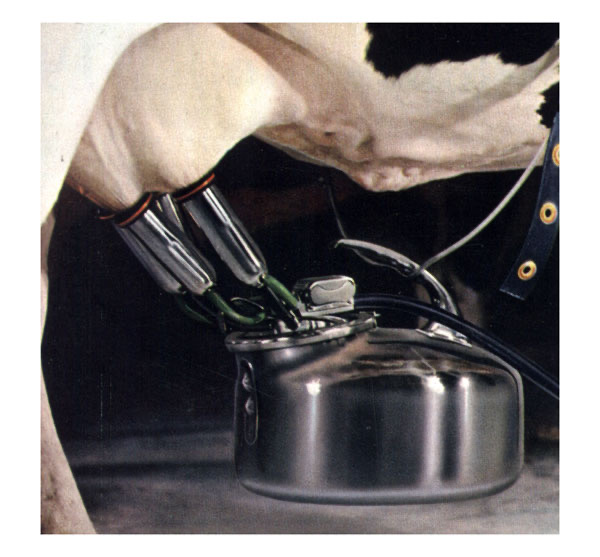
1930’s Era Compressor, Runs Five Milkers at One Time
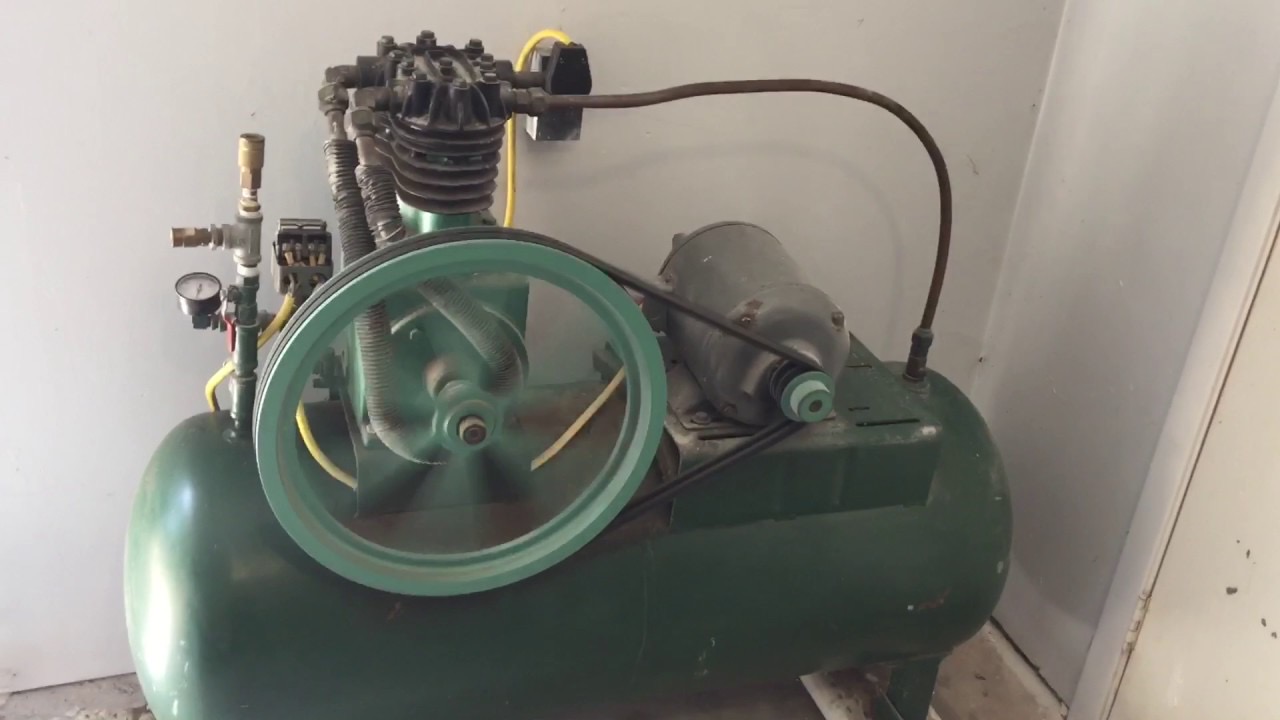
Cream Separator In Cellar
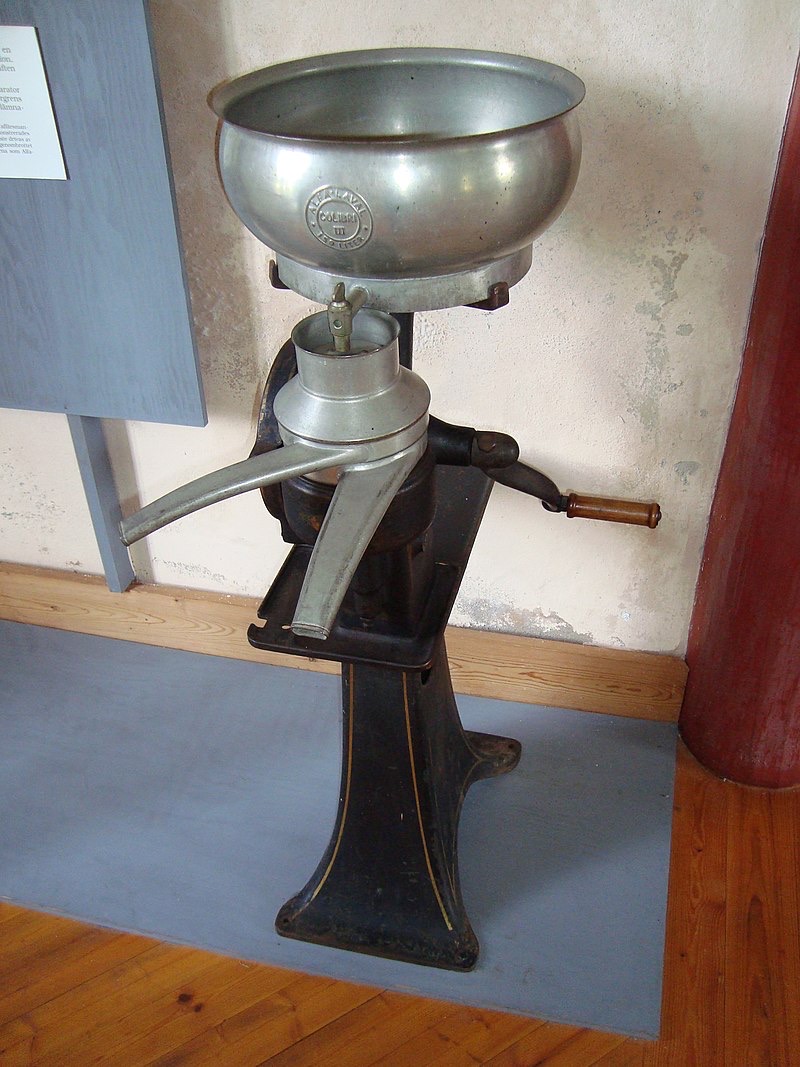
After we drove the cows into the barn Dad was the one who performed the milking; we had mechanical milkers (a post WWII invention). After 1956 the local creamery shut down (better supplies in the stores) so Dad sold the dairy cows which was a relief since there is so much other stuff to do on a ranch.
We Had A Mix of Jersey Cows
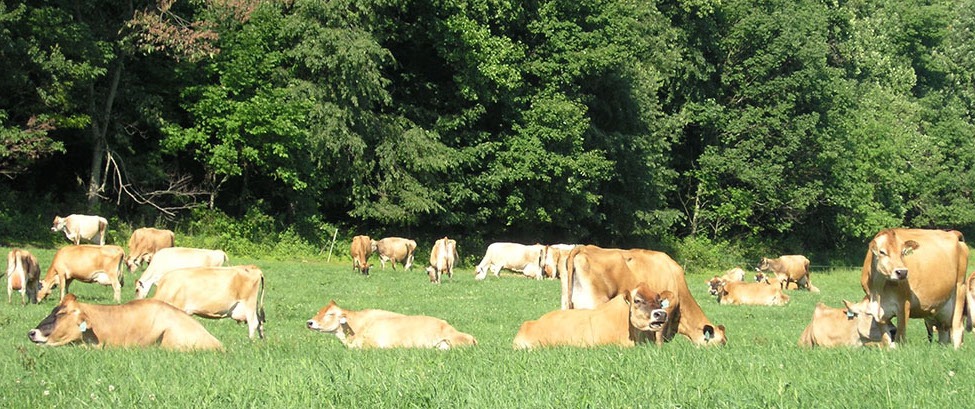
Winter Around The Valley
Winter in the 1950’s was also a time of lots of activities, mostly related to school. Basketball games were the meeting place for the entire community with 4 towns in the Valley fielding teams, every Friday night was a big get together. Remember this was the Post WWII Baby Boom and the schools were bursting with kids. The game was really secondary for the adults as everyone socialized and caught up on the week’s news. The men all gathered in the high school boiler room where smoking was allowed and proceeded to discuss farming and ranching.
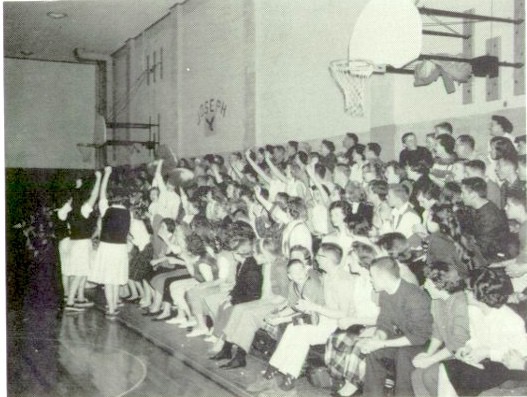
The holiday season was a time of school singing pageants and shopping. During the fifties all the sawmills were running and full employment meant the shops were full of shoppers on the weekends.
Main Street Enterprise, Mid Fifties, Holidays
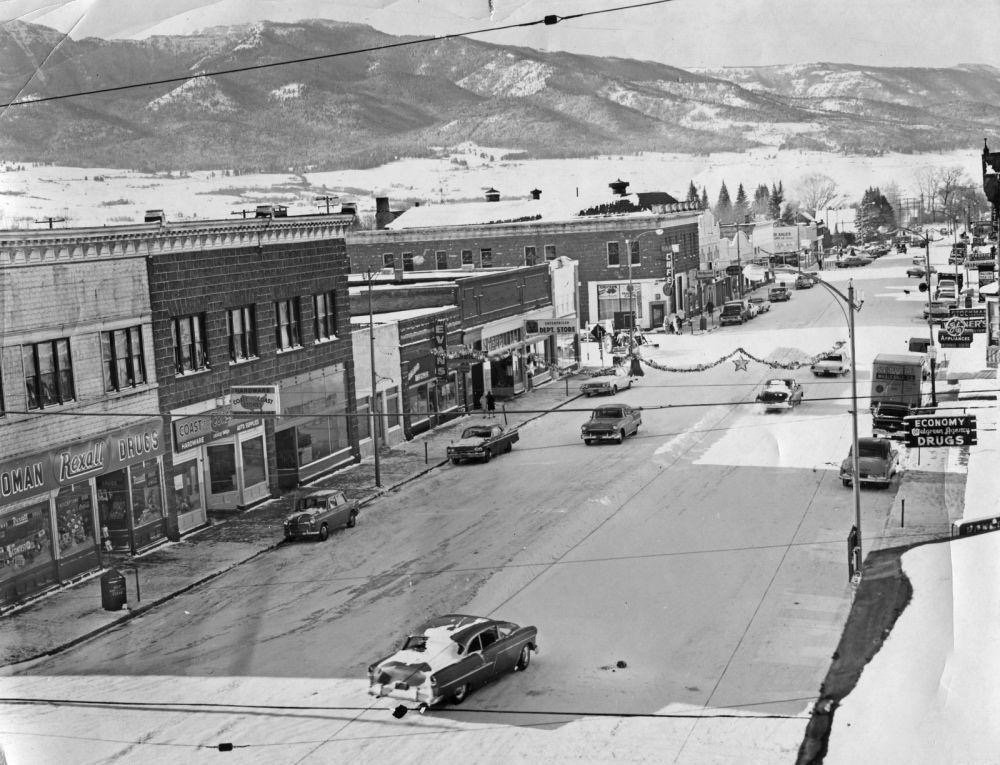
Weekends also meant the roller skating rink at the Joseph community center was operating every Sunday after church. On Saturday both theaters were relatively new and very busy with the latest releases from Walt Disney or Shoot’Em up westerns. Since farming and ranching was slow in the winter this was also a time when the parents attended many mid-week meetings: school boards, church planning, Grange Hall meetings, cattlemen’s association, Elks Club, Shriners, Masons, and others. Mom and Dad were gone one night every week for one of these activities. It was also a time of many banquets: Fathers and Sons, Mothers and Daughters, the annual Crab Feed, athletic end of season dinners, and many more. There was the annual talent show where adults dressed up and did silly skits, there was the Boxing Smoker to watch kids give each other a bloody nose, and of course there was the Saturday night county wide dance with your regional rock and roll band for the kids. The adults had the hotel Gold Room Bar with a honky tonk country western band and lots of inebriated cowboys. The front of the Gold Room was a dining area where kids could grab a burger and fries and observe which parents were having too much to drink.
And of course the best activity in winter was the Alpine Ski Club Run at the foot of Mt. Joseph. Every Saturday or Sunday after chores and church we would head up there in our WWII era jeep to plow through the heavy drifts on the road and have a day of skiing.
Dad With Back to Camera (to the left)
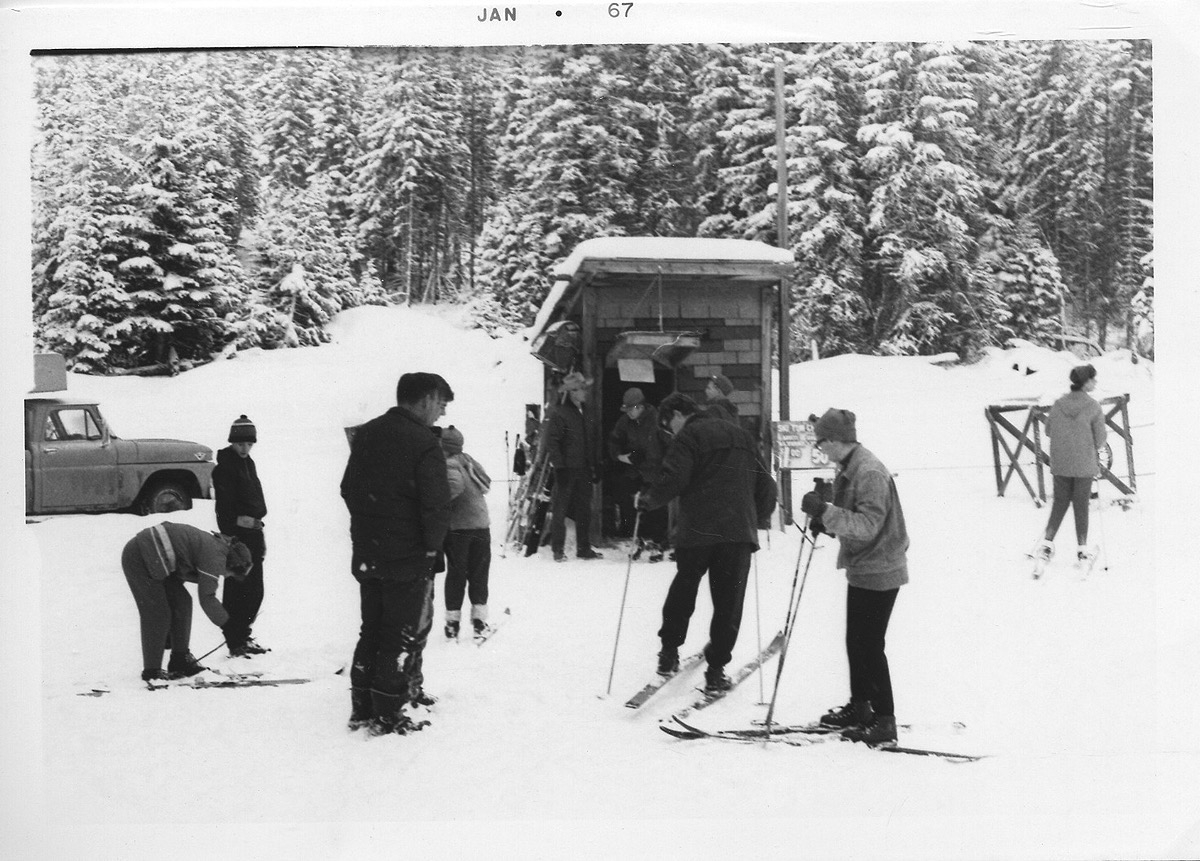
The ski slope had a rope tow run by an old car motor at the top of the hill and at the bottom was a food shack that could be loaded onto the back of a truck after the season was over. Hot dogs, pop, and coffee was pretty much it. There was no warming shack so you had to keep skiing to keep warm on cold days. Later in the early 60’s a warming shack with a double 50 gallon barrel wood stove was added. Also in the winter the creek behind the house would freeze over and flood a bit so there was an ice hockey area where we could ice skate. We all had skates from an early age
Winter In The Valley
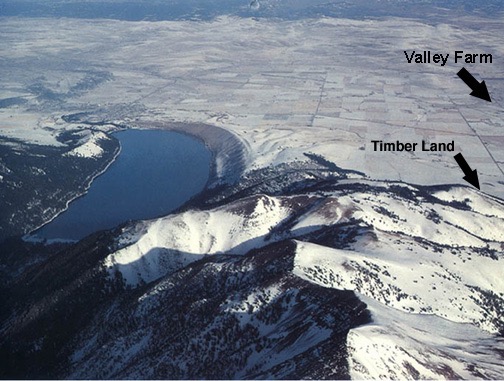
Winter on the Ranch was a slower time during November through January as bad weather set in. The only exception being rounding up the cattle on the Divide and driving them to the valley place and then feeding them everyday until the spring grass poked through the snow. Sunday was a day of rest after the cattle were fed. Since there was no TV and not much to do in town (also the roads might be drifted shut), we often spent Sunday reading the Sunday newspaper, listening to radio shows, playing board games or getting our ski equipment in shape.
When February came around calving season began which was a busy time checking on the cows every few hours (for 110 cows). It is important to calve when the ground is frozen and preferably when there is snow on the ground. If it is mild, wet, and muddy, many more calves catch a respiratory disease and die. If a young heifer was having problems we would drive her into the barn where we had a mechanical calf puller and Dad would put the chain around the calf’s feet (usually sticking out slightly) and we would coax out the calf trying to keep the cow calm. It was a suspenseful time since we were hoping the calf was still alive. But at least we could save the mother. Each dead calf would mean $300-400 dollars lost (in 1955 dollars) for the year.
Winter Calving Season
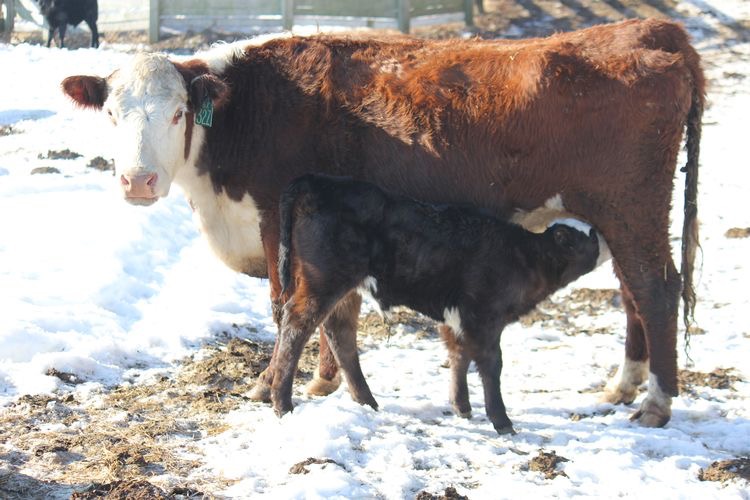
By the end of March the hay stacks were getting small and it was time for early spring and hopefully the grass would start to poke through the melting snow.
Spring Time in The Valley
In late March and early April spring time comes to the high mountain valley, about a month behind coastal climates. The snow in the valley has melted but there will be an occasional overnight light snow that melts by noon the next day.
Early Spring Frost

The frozen ground softens enough that the trees and plants can begin to take up moisture and start to develop buds. Sometimes the days are cold and sometimes a nice hint of warming. With the thawed ground it is time to plow the dormant fields that were grain crops last year and which were harvested. The straw stubble or old hay crop is turned under, then disc’d and then harrowed. This breaks up the soil into finer pieces. Finally a seeder is used to insert seeds for wheat, oats, barley, or grass hay or alfalfa hay into the soil.
Plowing Under Last Year’s Crop
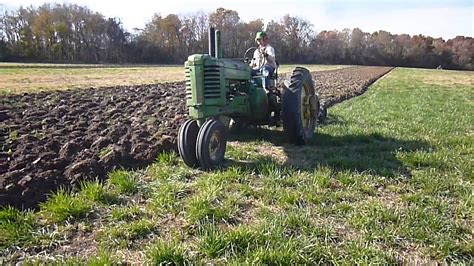
Disc’ing The Plowed Furrows
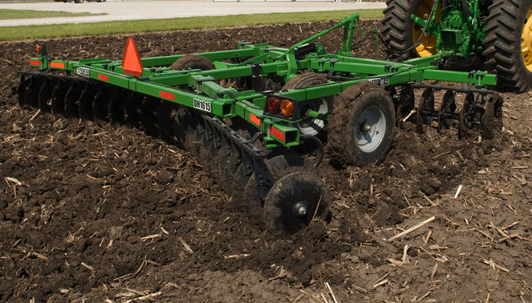
Harrowing The Disc’d Soil

Inserting Seeds With Seeder
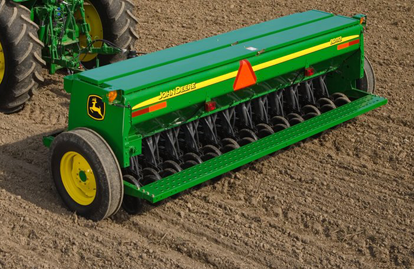
When the seeds are in it is time to turn to other chores while the seeds germinate in the spring rains.
By mid April the mountains are still snowed-in but the dormant valley is alive once again with activity and nature. Farming is in high gear preparing the soil for planting, logging is starting in the lower canyon country, and the stores in town are once again showing economic activity.
Late Springtime In Wallowa Valley
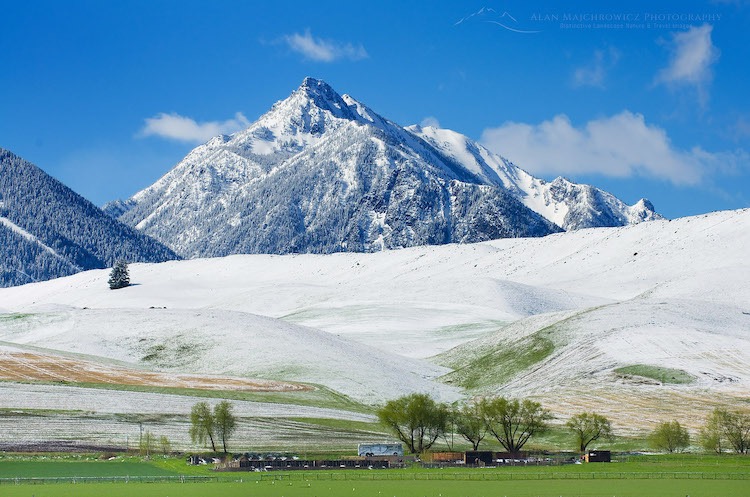
In high school the sport is track and kids are running along the muddy road sides jumping over a stubborn snow drift that is slow to melt. It’s a time to take off the heavy jacket and feel the warmth of the sun for the first time in months (50° is warm).
Early Summer Time in The Valley
By late May everything is in full tilt ranching, farming, and logging throughout the county. The crops are well out of the ground and the cattle are ready to be moved out to the Divide for summer pasture. Now is a time to irrigate, prepare the young calves for the summer, and get the machinery ready for summer haying season.
Branding, Vaccinating, and Castrating Male Calves
Dad, Clyde, Aaron, Mia (Roger on camera)
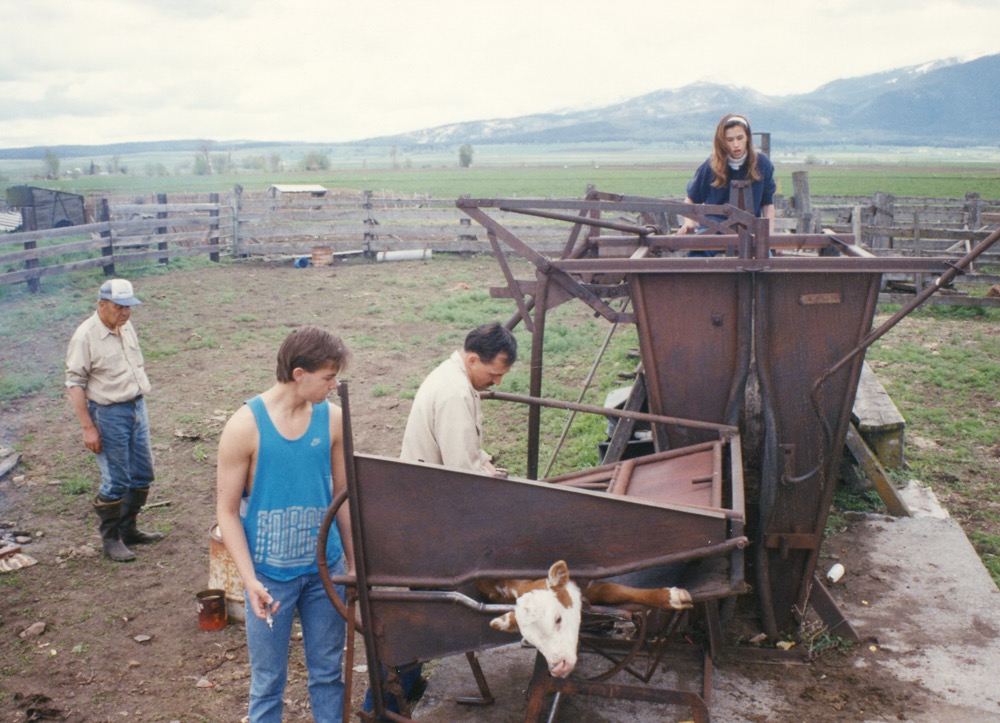
For the cattle the first thing is to prepare the new young calves before driving them and their mothers to the Divide pasture. This is not a pleasant process and should have been updated with new techniques years ago, however, this is how it went: drive all the cattle into the large corrals and separate the young calves from the cows (which can be highly stressful); run the calves through the holding chute; castrate the males, de-horn with a red hot branding iron, brand them with a hot iron, and vaccinate them. I have written an essay on this stressful process you can read in another chapter. The bloody faced calves rejoin the mothers and are left to recover for a couple of weeks then we round them up early one morning and begin the two day cattle drive out to the Divide pasture.
Driving The Cattle Out To The Divide
Cows with small calves walk very slowly while mothers graze on a cattle drive, so it takes a while to cover 20-30 miles of roads. With the yearlings (last year’s calves) plus the cows and new calves and 5 bulls there will be almost 300 head of cattle on the drive.
The Cattle Drive Along The Roads To The Divide
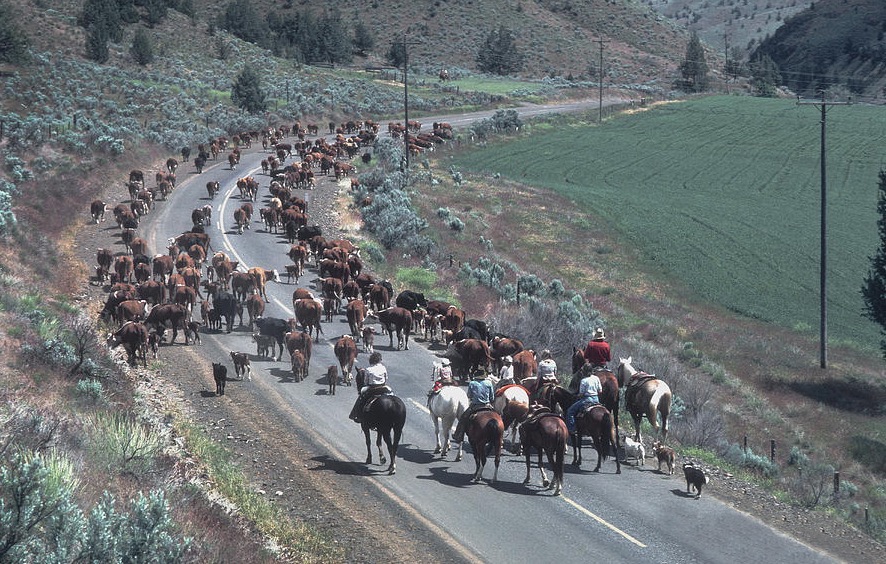
Since you drive the cattle right down the middle of the highway you have to deal with cars and trucks coming both ways. When coming from the front of the herd, locals know enough to park their vehicle and wait for the cattle to stream around them. For cars coming from the rear, one of us must ride in front of the car and open a path through the cattle. In the fifties and sixties the traffic was light so it was not too bad with only a few cars before we got off the highway.
Route to The Divide = Red, and Return Route With Horses = Yellow

The only bad accident was when a logging truck at full speed rounded a bend on the Imnaha Highway and ran into a band of sheep. Many sheep were killed; we always took an alternate detour and avoided that curve. When the herd was breaking out on top it would be lunch time and Mom would show up with one of her wonderful picnic lunches, the highlight of the day. We would stop to eat and the cattle would mosey on ahead a little.
Picnic on The Divide, Above The Rim Rocks, 1990’s
Mom, Dad, Andrew, Bryce, Roger (Wendy on camera)
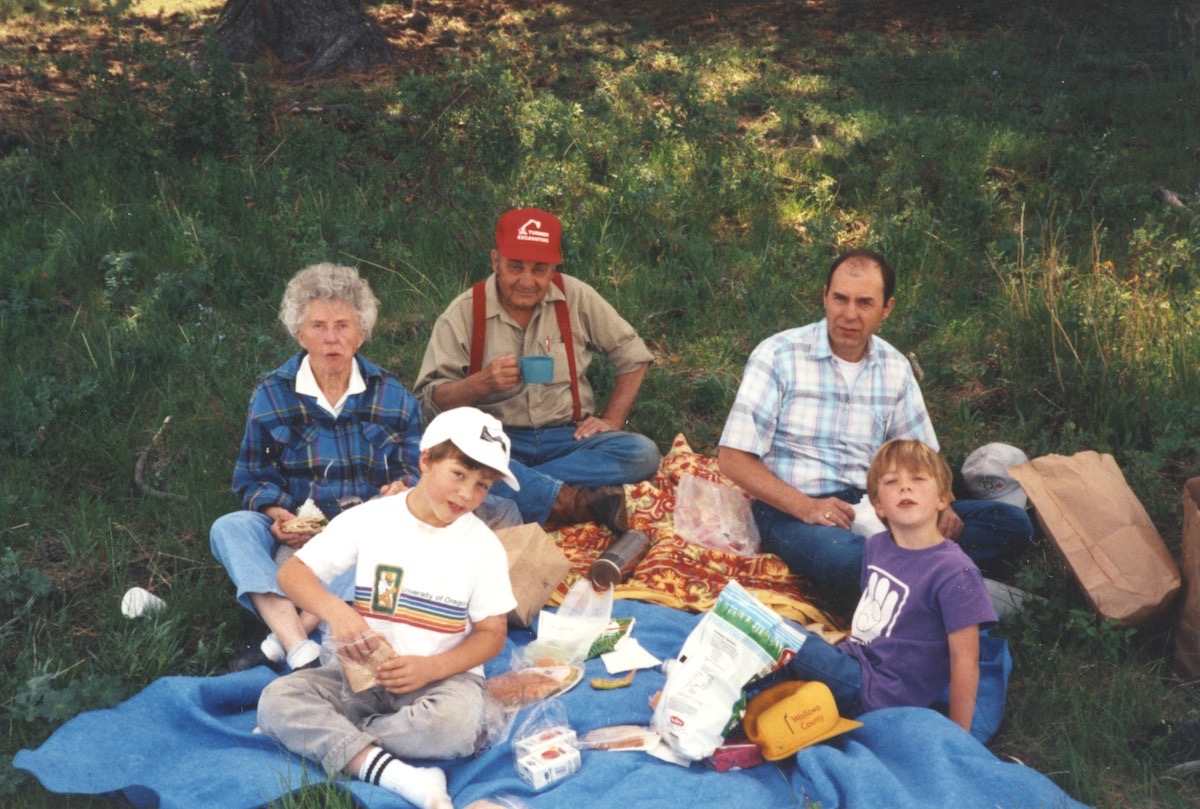
After lunch we continued across the top of the Divide, no longer down in the canyons and this is where the views are spectacular in all directions. East are the Seven Devil mountains, to the North are the buttes, and to the South and West are the Wallowa’s.
Views West, Driving Cattle Across The Cat’s Back
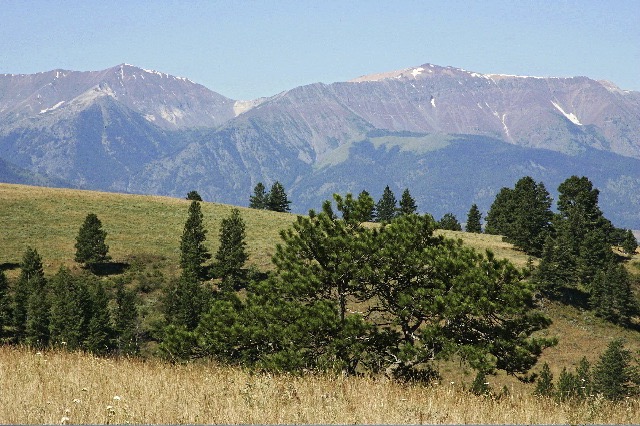
The road goes over a very narrow, rocky area between two canyons called The Cat’s Back of which a book has been written about homesteading there in the late 19th Century. At this place in the rocky road we would stop and as irresponsible kids, roll a few boulders down the canyon side into Big Sheep canyon. We never thought about whether there might be someone working their cattle down there.
Around The Cat’s Back, book by Jerry Gildemeister and Don Gray
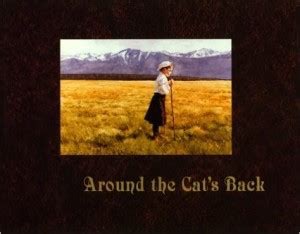
View From Cat’s Back Down Into Big Sheep Canyon, Looking East
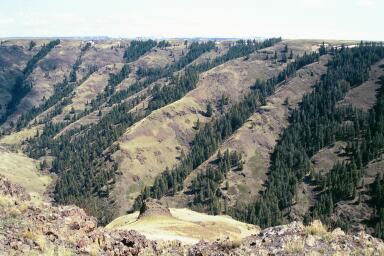
By sundown we are about 4 miles from the gate to the grazing lands and so we rest for the night at the corrals of a neighbor we know. The cattle are put in a small fenced pasture that has a pond and the horses are put in the corrals. We put the saddles under a tarp by the corral, climb in the back of the pickup, and head for home. On our way home as we are jostled around on the rocky road and we fall asleep. After supper we shower and hit the hay knowing that we will be getting up at 5:00 am to get ready to head back out to the cattle.
We arrive at the cattle around 7:30 am the next morning and they are balling for grass and the horses want some oats. We catch and feed the horses, curry them down, saddle them, mount up, and open the gates letting the cattle stream out into road which has broad shoulders to the fence and lots of grass in between. The cows start filling up and moving slowly toward our land. It takes another couple of hours and to reach our gate.
Standing At Our Gate Looking North, Old Homestead and Downy Lake Ahead
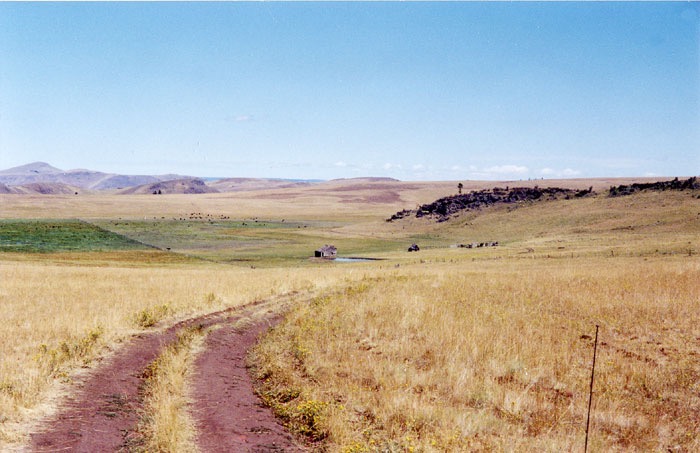
We reach the gate and push the cattle through and they immediately begin to spread out across the open range. From this time on we will only look in on them once a month until we round them up in fall. They have 2,000 acres of canyon country to roam around on and do nothing but eat.
We drive on down to the old homestead and have our lunch before heading out westward on the horses toward home.
Looking South, The Old Homestead in Foreground
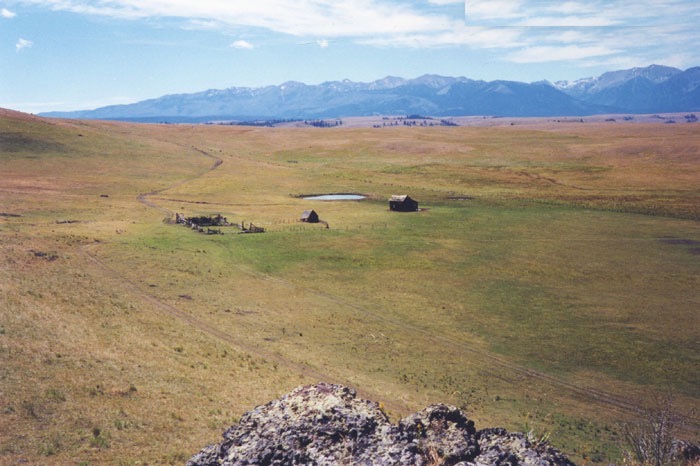
Clyde’s Photo of Butte Above Downey Lake in Early Spring, After A Wet Winter
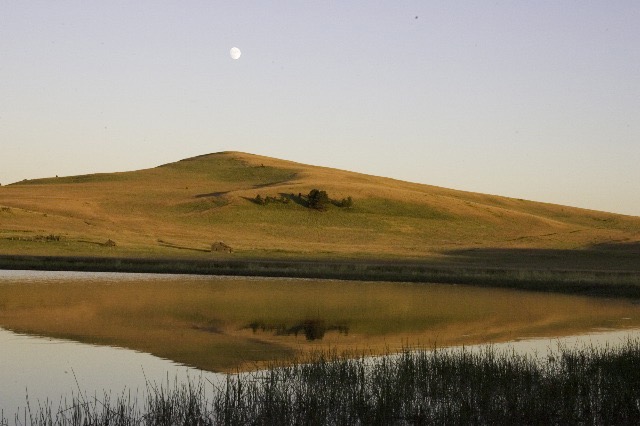
Downey lake is a natural basalt depression that fills with snow melt in the spring, there is no creek that feeds it. It is one of very few high elevation, marshy nesting grounds that is available to birds in the early spring in Oregon. Over 250 species of birds have been documented by The Nature Conservancy as nesting at Downey Lake. The TNC bought the land abutting our property and own part of the lake. With climate change and less snow it may dry up except for early spring.
The Ride Home
This is the most enjoyable part of the cattle drive for us kids. Dad will drive the pickup home, but for us we get to ride for several hours across open country, just like the Nez Perce Indians centuries ago. The horses know we are headed home and you have to reign them in or they want to trot.
The Ride Home Over Open Country, No Roads (photo is late summer, drier landscape)
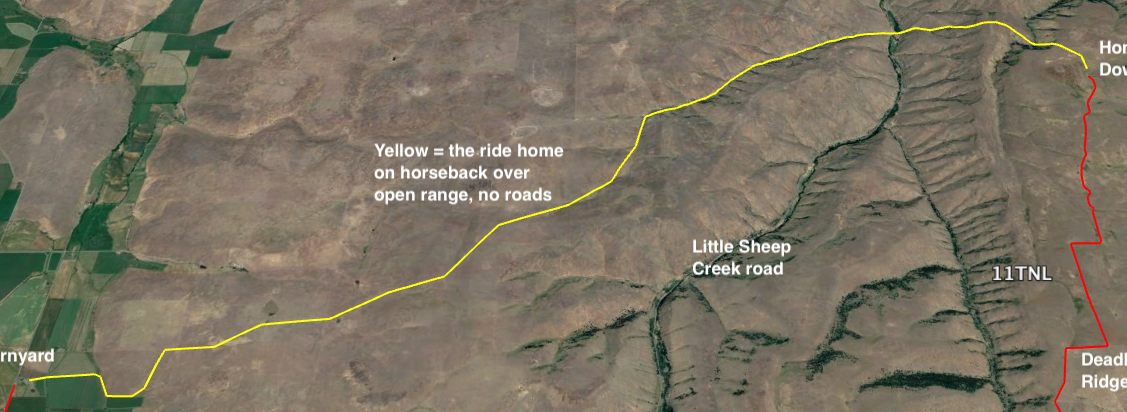
We come into our grazing land on the back hill of the valley place, ride down to the barn, unsaddle the horses and turn them out down the lane which runs to the back hill. The horses kick up their heels and run down the lane knowing they won’t be ridden again for awhile and will be free on the open range. Now it is time to turn back to farming and get ready for the rapid growth of the crops.
Summer Farming
Getting Water To The Crops
Dig The Irrigation Ditches
The crops were all planted in the spring when the ground was no longer frozen and now they are just starting to poke up through the soil. Before they get too high it is time to dig the ditches across the fields to allow the water to flow and flood the fields. This is a pretty boring job for a pre-teen driving the tractor behind your Dad as he handles the bubble-level-survey-board and finds the gradual down hill slope for each ditch. There will be multiple ditches across the field in a terraced pattern, each about 50-75 feet from the last ditch.
Here is the process: the John Deere tractor has an angled ditcher on the back end which is lowered into the soil; Dad has a 12 foot long board with a 36″ high foot on each end and a bubble level in the middle. One end of the board is placed at the last point of the growing ditch and he rotates the board so the other foot is slightly downhill (water only runs downhill). The pre-teen notes the new foot point and drives the tractor to that point (the ditcher digs a furrow at the same time) and waits for Dad to take another reading. And this goes on all day long for several days to put ditches in all the fields. This is before sprinkler pipe systems came into use.
Tractor With Hydraulic Ditcher
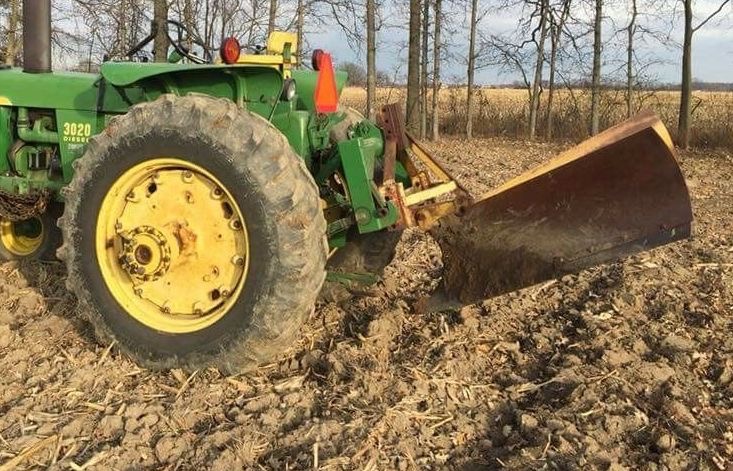
When the rains stop and the soil starts to dry out, Dad goes out each day with a shovel and walks the fields starting or shutting off the water flowing in all the ditches. Small ditches in the fields are connected to a larger ditch that runs from the box dam in the river out to the end of the field. There are gates at the dam that direct the water and you use the shovel to place sod where you want to stop the water in a small ditch and redirect it to another small ditch. It takes several hours to do this, stopping for lunch of course. As a kid I never appreciated how much knowledge this takes to get an even flow of water across all the crops. Dad must have been pretty skilled at irrigating with a shovel. When sprinkler pipe irrigation arrived this all went away.
Guiding The Water With A Shovel, Twice Daily
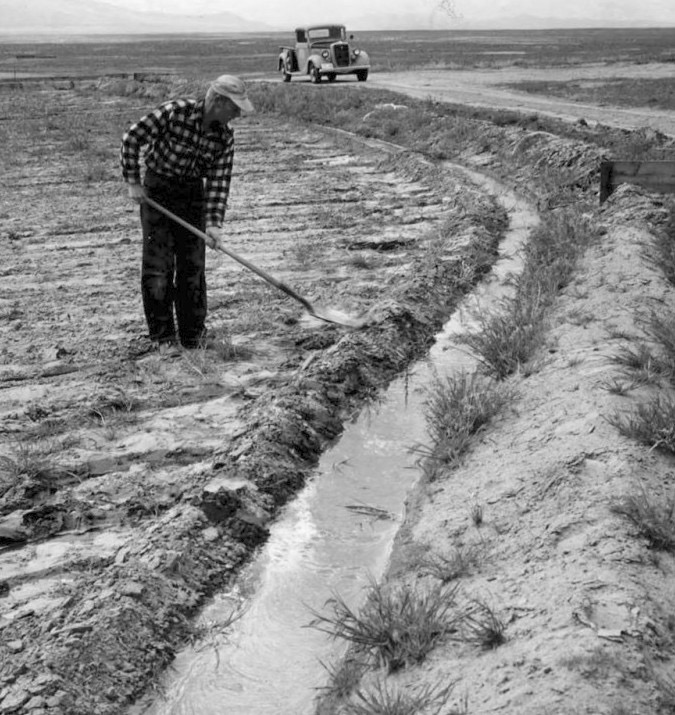
Now it is early June and the crops are really starting to grow. The sun is out every day and photosynthesis is ramping up in the cellular biology of the plants. Sun and water means growth. Later in the mid fifties Dad switched from ditches to hand lines which are individual pipes that are moved once every 8 hours, once in the morning and once in the evening. There are usually 5 or 6 of these lines each running completely across a field. Of course it falls to kids to move these lines.
The water in the lines is pumped from a large electric motor located in a pump house next to the river. This motor pumps water into a medium sized 9 inch diameter water line buried in the soil that runs the length of the fields and from which spigots pop up every so many feet. You attach the hand line to a spigot to direct water out into the field. The biggest problem is when a sprinkler head pops off the hand line and water gushes up all over the place, wasting valuable water. Then you have to shut down the pump line and repair it, often when you have better things to be doing. This equipment is all expensive and a significant investment that requires a loan, just like a house mortgage. You pay off a bit of the loan each year when you sell the crops and cattle.
Hand Line Pipes
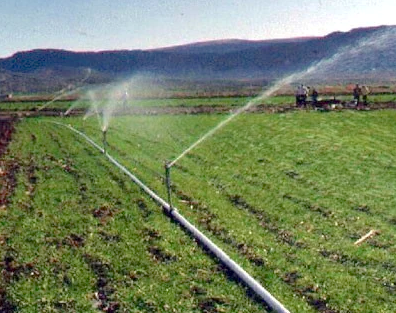
By the mid sixties Dad put in wheel lines that are moved by a motor in the middle of each line. One person can move an entire line very quickly but they are much more expensive. You pay for it by not hiring town kids to set the pipes (if you don’t have your own kids). More automation, fewer people on farms.
Wheel Lines On Back Fields, Note: Not Much Hay Was Used or Sold Last Winter
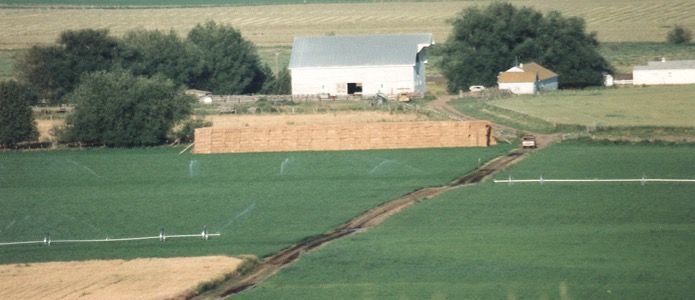
Getting Equipment Ready For Haying Season
Hay Equipment In The Fifties
Model A and Mower, We had two of them Rake to make windrows
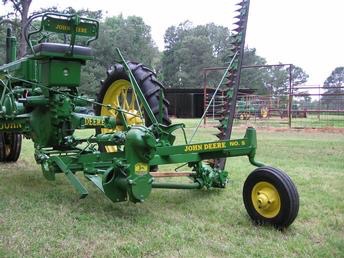

Hay Baler (complicated device and dangerous, breaks down a lot)
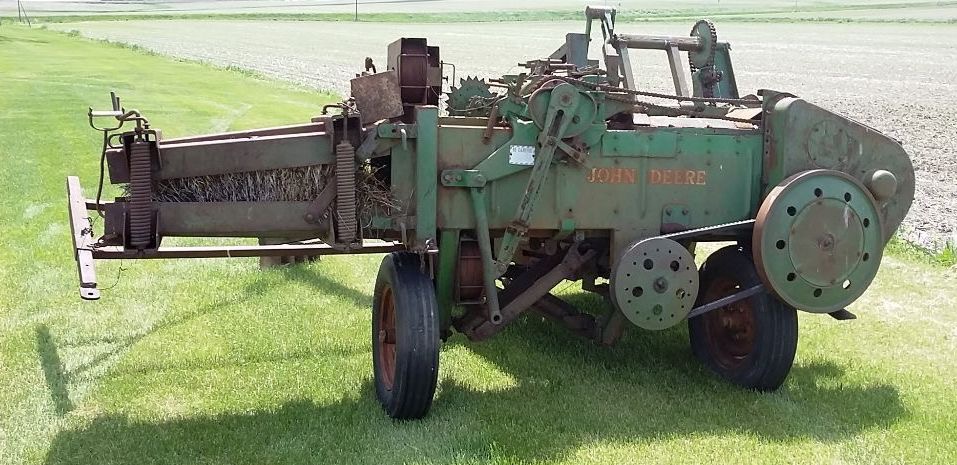
Each of us, depending on ability, worked on a piece of equipment that they were capable of using. David and Clyde (being older) worked on the mowers, I on the rake, and Dad on the baler. Adding oil, greasing, replacement of worn out teeth, sharpening, tightening bolts, and attaching the implement to the power take-off on the tractor were some of the duties to prepare for haying season.
Bringing In The Hay Crop
Standing in Hay Fields Near Back Hill, Late June
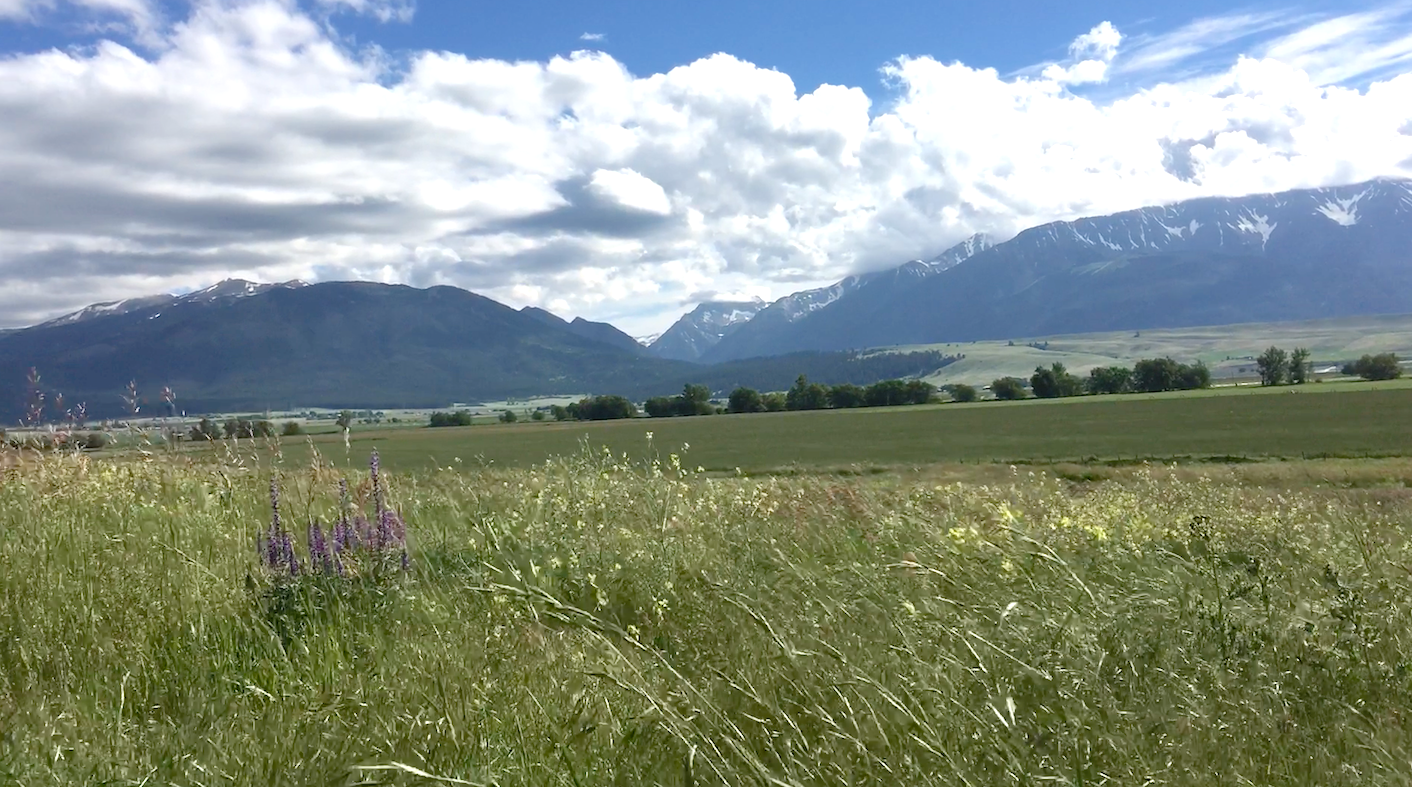
There are three types of hay crops in Wallowa County (plus the wheat crop):
– Alfalfa Hay The most valuable to sell and best for nutrition; restores nitrogen to soil
– Grain Hay Usually oats mixed with a variety of grasses
– Grass Hay A mix of grasses with a preponderance of one type like Timothy
We usually planted alfalfa and grain hay crops. Alfalfa returns each year and does not need to be planted whereas oat and grass hay is planted each spring. The alfalfa hay crop is ready to harvest when it reaches about 28 inches. Waiting longer to harvest will result in loss of protein value so you must be ready to go when it reaches this height (no taking the weekend off for recreation). Oat hay is harvested when the head is just starting to form, before it flowers out. This is the highest protein point of that crop. Due to the cool weather in WC the oat hay usually matured after the alfalfa crop.
Timing is everything and from the moment the crop is ready, the farm is in constant motion from morning into the evening. The unknown variable is the weather. If it rains, cutting must wait a day for it to dry out or if the hay is on the ground the hay must be turned (raked) so that the wet side is up and dries out. Turning the hay retards the growth of mold. Also when wet hay is aggregated (baled or piled up) it generates heat and can self ignite. Usually from July 4th on the weather is reliable so that is when hay season usually began. The routine is 1) mow the field, 2) let it sit one or two days, 3) rake the field, 4) let sit one or two days, 5) bale the hay, 6) let the bales cure a few days, 7) gather the bales on a wood slip or low wagon pulled by a tractor and take them to a hay stack or the barn and unload them. It takes about 1 to 2 weeks depending on the weather.
Mowing The Hay Field

Raking The Mowed Hay into Windrows
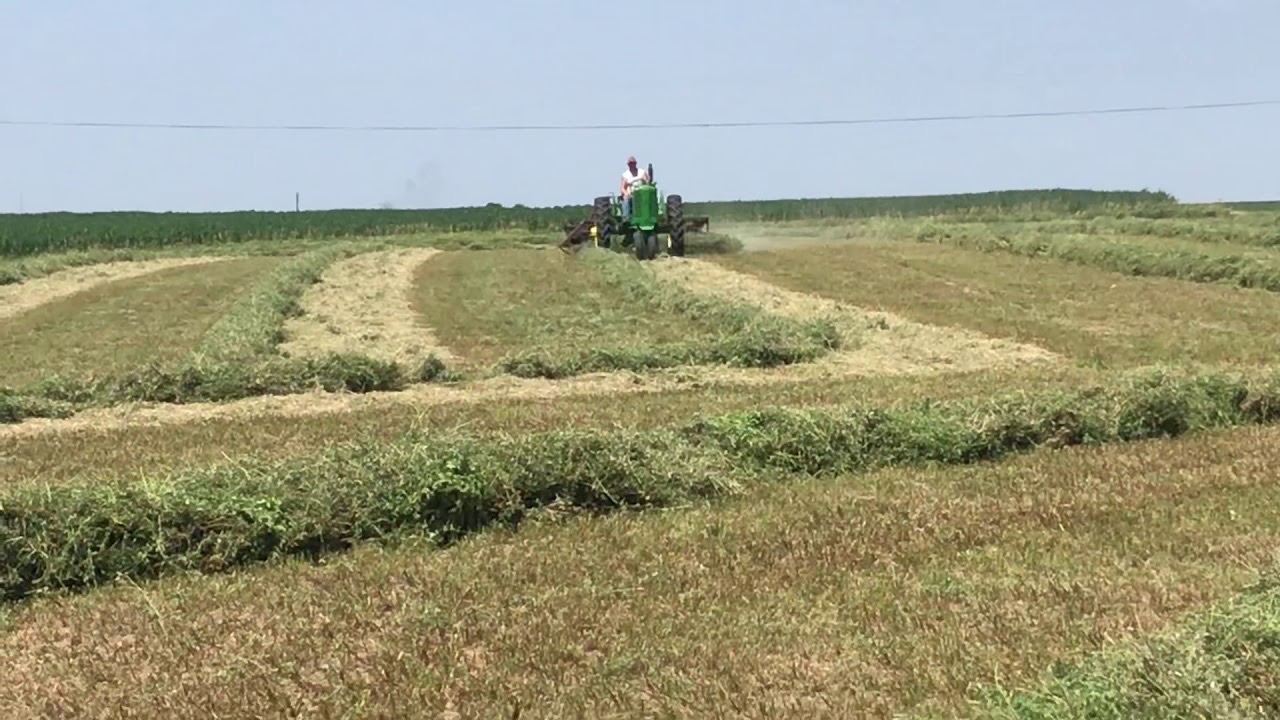
Baling The Hay (should be John Deere tractor)
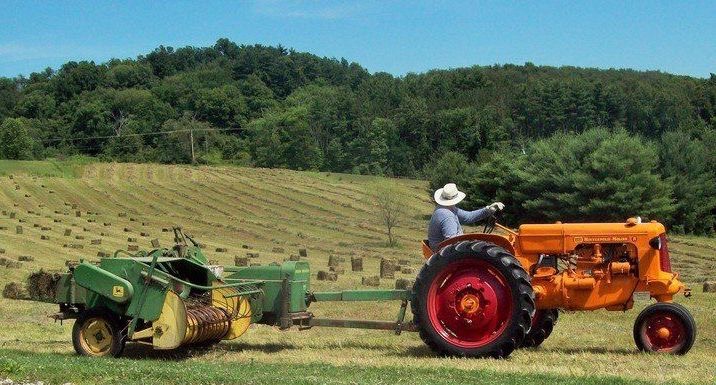
Picking Up Bales From Field
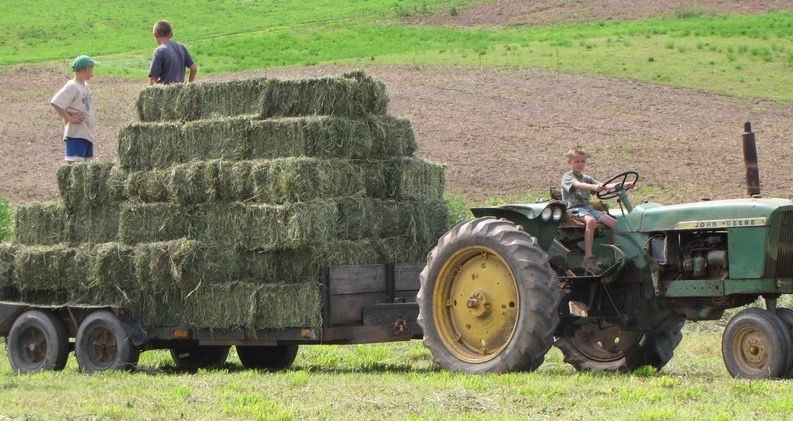
Hay Elevator From Wagon or Slip Up On Top Of Stack
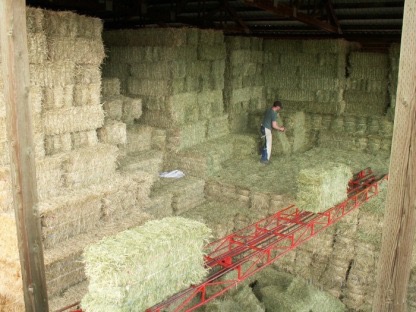
When the last bale is placed on the stack the first cutting is done and it is time to relax a bit and wait for the grain hay crop to ripen. Bringing in the grain hay is the same process and then in August there can be a second alfalfa crop but it will be only about 40% of the first crop. As soon as the first crop is in it is time to irrigate the fields again.
Sweet Peas
In some years, after 1960, we also grew eating sweet peas for Flav-R-Pac a commercial processing company located in Weston, Oregon (on the way to Walla Walla).
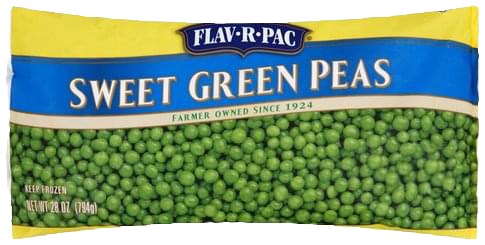
Sweat peas grow on vines that reach maturity in mid-July. The huge equipment to harvest the peas required flat ground and no irrigation ditches, so this was after we had converted to hand and wheel lines to bring water to the fields. Peas need a lot of water so we were out there every day at 5:30 am and 5:30 pm moving the pipes. When near maturity the vines are tangled and it is hard to walk the pipes through the grabby vines. The only positive is the color in the field and near maturity you could pull pods and eat some peas as you worked.
Sweet Pea Vines
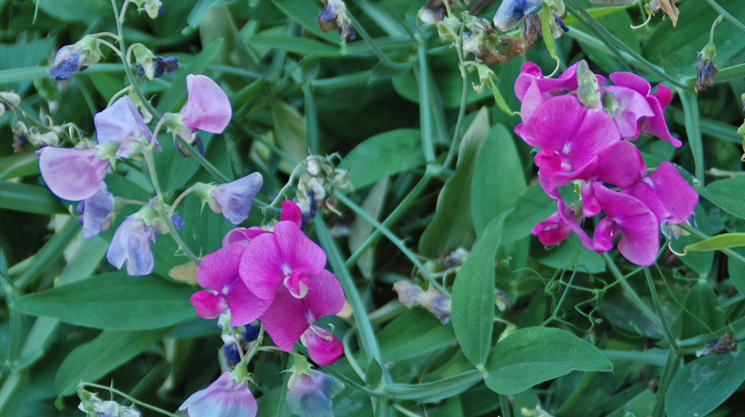
When the peas are ripe, Flav-R-Pac brought it’s harvesting equipment to the valley to do all the peas at one time. Once they began, the harvesters and viners operated 24 hours a day non-stop. The valley is lit up like a carnival at midnight as the crews work several farms at once.
Pea Harvesters
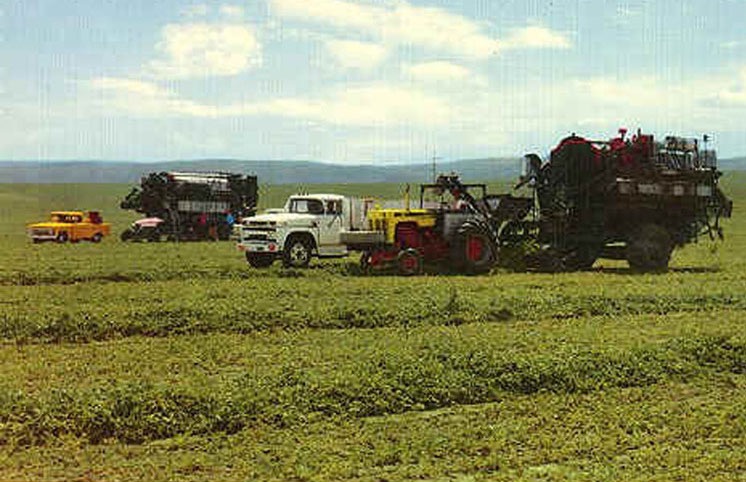
The pea harvesters move into a field five or six at a time and move in a staggered formation around and around the field. As the harvester fills up with vines a truck drives beside the harvester and accepts the vines. Then the truck drives the vines into Joseph where it dumps them at the mouth of giant machines to separate the pods from the vines. I worked two weeks one summer as a teenager feeding a viner in Joseph.
Truck Unloading At The Viners
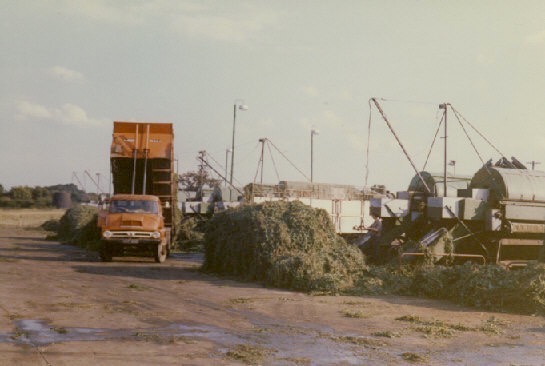
The peas are popped from the pods and drop onto a conveyor belt which carries them to a large stainless steel bin. The bins are then trucked from Joseph, over the mountains to Weston where they are then cleaned and frozen into packages.
The vines are bulldozed into a huge long hay stack called pea silage where they set and ferment all summer and fall (quite smelly, they look like spinach). In winter we would drive our old Dodge truck to the vine stack, load up, and then bring them out to the ranch to feed our cows. The cows love the vines (warm, tasty, and smelly) and they are much more nutritious than hay. The vines are wet and steaming when tossed to the cattle, a treat in mid winter…. munch, munch, munch.
Pea Silage Stack
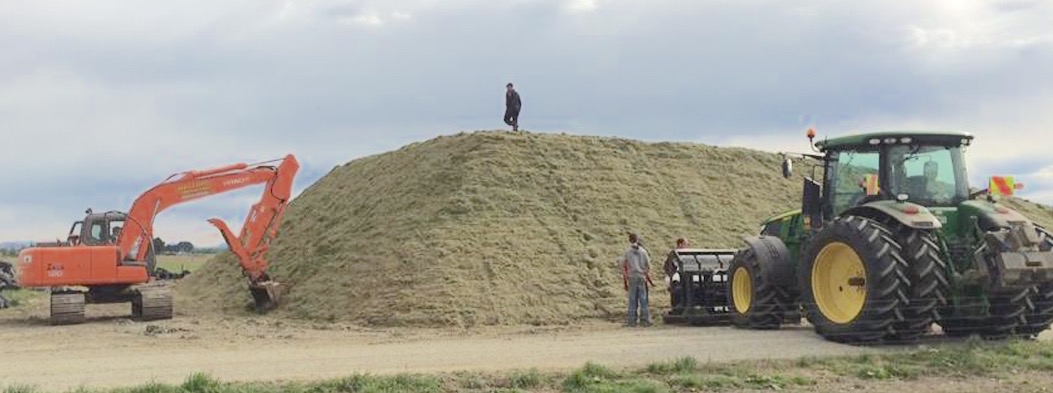
August, A Slower Time Before Fall Harvest, The 4-H Fair
By mid-August the crops are in and there is time for other routine work and activities like the annual Wallowa County 4-H Fair, a really big event in the fifties and sixties. Nearly all the kids on large and small farms raised animals all year long in preparation for this event. There were beef and dairy cattle, sheep, swine, rabbits, chickens, and then baking, sewing, and other home arts.
In The Show Ring At The Annual 4-H Fair at The Fair Grounds
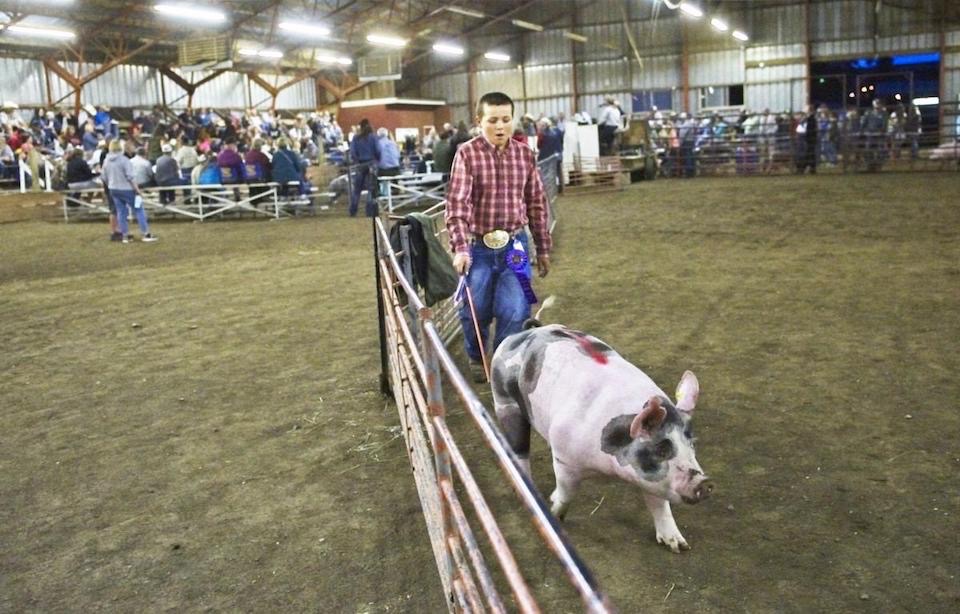
The week before the fair the ranch is a beehive of kids working to get their steers ready to take to the fair. First the two year old steers must be trained. By now they weight 1,200 lbs or more so in order to teach them to be led you use the John Deere tractor to pull them around and around the barnyard until they get the idea they have to come when you pull on the halter. Now that they are docile and follow you it is time to manicure this huge animal just like you were going out on a date. The hooves must be trimmed, the hair cut, ears cleaned and hair trimmed, tail combed and trimmed, then wash the steer and clean off any manure stains. Wipe his nose and eyes, and step back to take last look to make sure you haven’t missed something.
Two Year Old Herford 4-H Steer (Hockett’s raised Herfords)
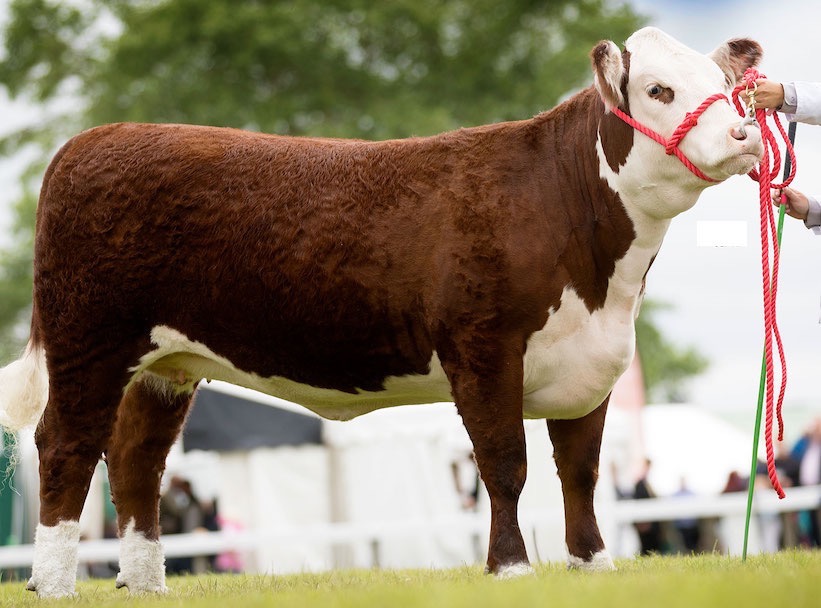
Now it is time to load the animals (usually all three of us had steers: David, Clyde and Roger; I’m not sure about John who came later) in the truck and drive them to the fair grounds in Enterprise. Unload the steers and lead them to the barn where the Alpine 4-H club (our club) had its pens. There is one pen for each steer and the pens have fresh straw for the animal to bed down (clubs are judged by their appearance). By now you are getting the picture in your mind that the steers are being pampered and are enjoying this. Generally they just lie in the pen and munch on grain, hay, and water as the child pets them.
Fair Barns In Background, Sheep Exhibitors Line Up to Enter Ring
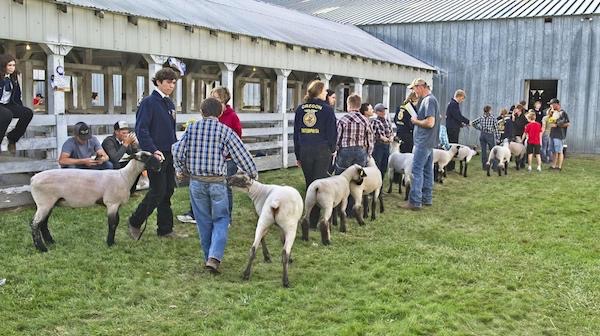
The morning of your competition you must get to the fair grounds early so you can get your animal very clean for the day’s events (steers get dirty in their pens from lying in their manure).
The first thing is to wash them off again. The wash racks are a long line of pipes with garden hoses attached. The steer is tied up drenched and then using brush and bucket of sudsy soap you scrub them down. Clean the nose and ears, wire brush the hooves, dry them off, curry their hair coat, and finally lead them back to the club barn.
Early Morning At The Wash Rack At The Fair Grounds
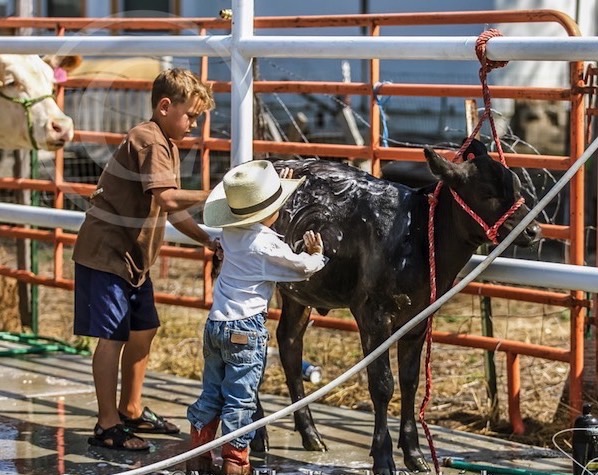
Now it is time to go change your clothes, put on your new Levi’s, plaid shirt, and the new straw cowboy hat. Soon it is time to lead your steer down to the show ring and wait for the event to start. Events are divided up into those about the quality of the animal (conformation) and those about how the 4-H student exhibits the animal in the show ring and how well cared for the animal is (showmanship). If you were lazy and your steer is dirty you won’t get many points. If you have trouble controlling your animal in the ring you get marked down on the judge’s score card. Eventually the judge lines all the contestants up in a row from highest points to lowest and then takes a microphone and explains to the crowd why he placed the animals in that order. Top steer gets a Grand Champion purple ribbon, then there is Reserve Grand Champion (a smaller purple ribbon), Blue Ribbons, Red Ribbons, and then White. This is what you spent 12 months every morning and night working for….a ribbon.
On the last day of the fair it is time for the auction when all the animals are sold that aren’t breeder animals (females). This is a sad time for the kids who have become attached to their animals like pets. The kids know the animals are headed for the dinner table and there are a lot of tears.
Auction After 4-H Fair Closes
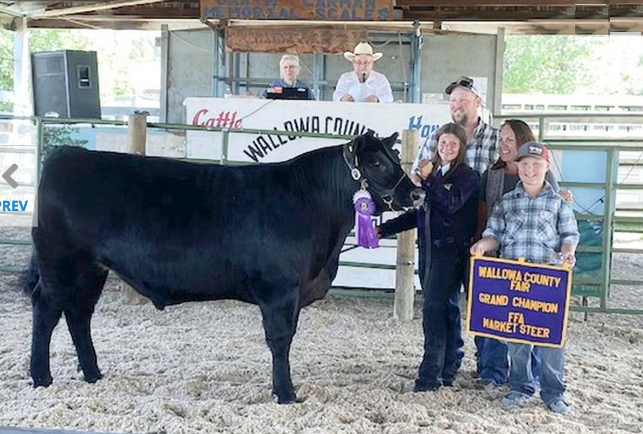
Labor Day Cattle Auction Time
At the end of August it is time to take the horses out to The Divide again and round up the two year old steers and bring them back to the valley place for a few days of rest and feed before driving them to market at the annual auction in Enterprise. Since one is paid by the pound for cattle on the hoof it is important to drive the steers slowly and not work off their weight. There are almost 100 steers to drive to the valley place.
Driving Steers into The Valley Place in Late August

Driving the steers from the valley place to the auction yard in Enterprise is a little stressful since you have to drive them on busy backroads that are paved and have traffic with lots of tourists that do not understand how to behave around cattle.
The Roads To Drive the Steers To The Auction Yard
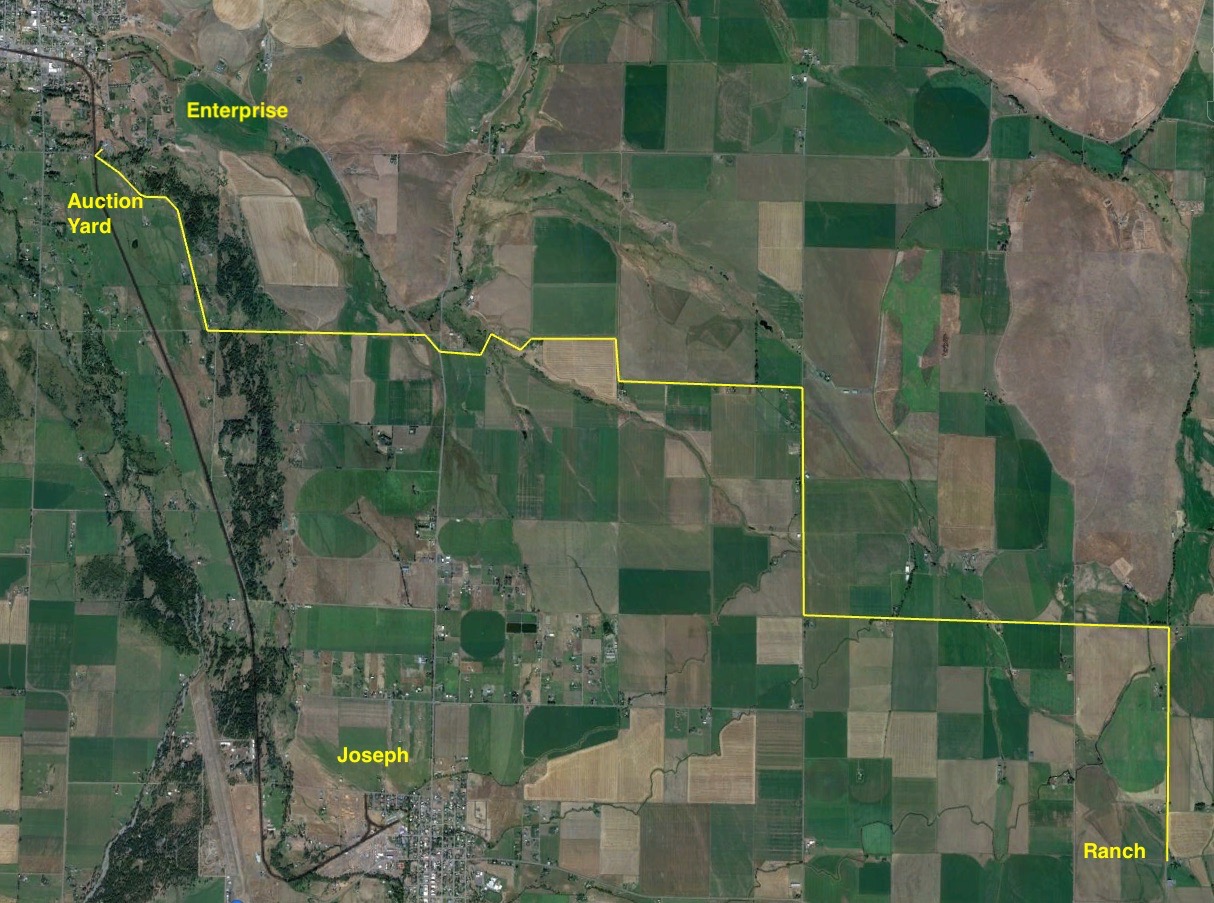
After the cattle are put in pens at the auction yard we turn the horses for home and ride back to the ranch. Two days later we attend the auction and Dad will hope for a high price on the cattle so he can pay off all the bank loans that were taken out in the spring. Later in the early evening we eat at the annual Cattlemen’s Association BBQ dinner with all the other ranchers.
Now school starts and us kids are absorbed in school activities. Dad meanwhile starts working on the combine to harvest the grain crop. Mom is gathering together many fruits to begin the process of canning them in jars to store up in the cellar during winter.
Fall On The Ranch
Fall in the County is a busy time with many school activities, especially football season and also harvesting the grain crops. The tourists mostly leave after Labor Day and the stores that are open are busy providing rural products and services. The evening temperature drops into the high thirties but the days are sunny and crisp. Sometimes there is an early snow that quickly melts off. For Dad it is time to get the old International Harvester combine ready to cut the wheat and barley crops. Because the combine is only used a couple of weeks a year Dad bought a old used IH combine and spent hours each fall getting it in shape to harvest the grain. A real rattle trap but it got the job done. Dad would cut grain while we were at school and unload it into the grain truck parked nearby.
International Harvester Combine, 1960
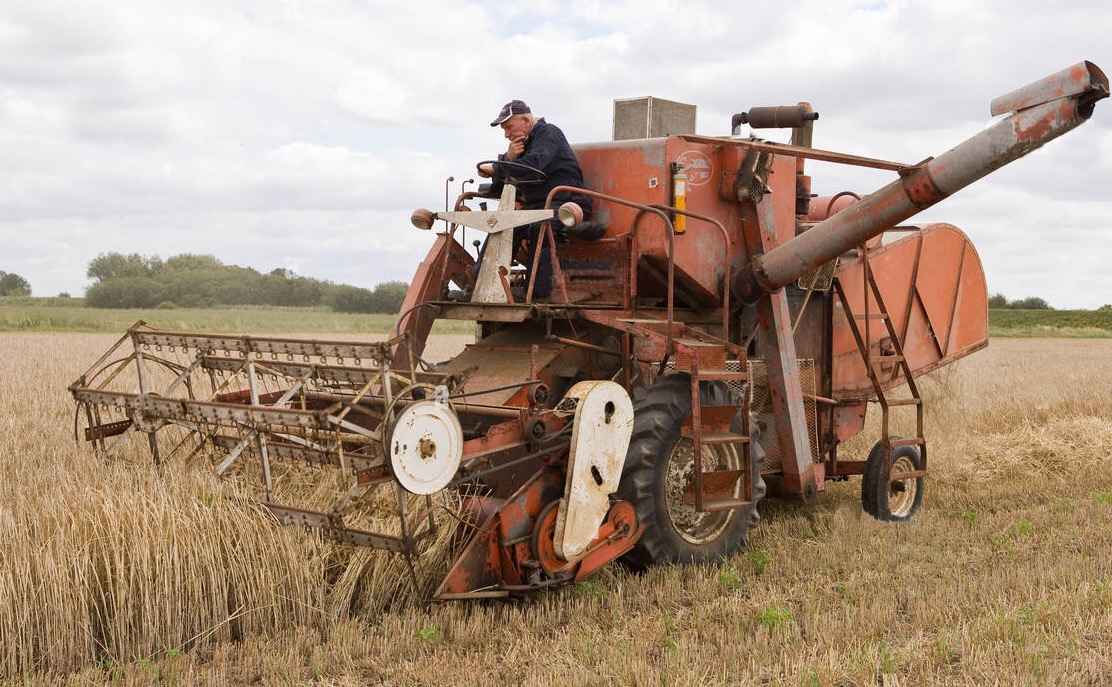
When we got home on the bus one of us walked up to the field and drove the truck down to barnyard and shoveled the grain into the grain elevator which augured it up into the granary (now a building to stay overnight in). Some years we would drive the truck into town to the commercial grain elevator in Joseph and it would be sold at that point to buyers from around the country. This choice depended on where Dad thought grain prices would go in the next few months, up or down.
Filling The Grain Truck
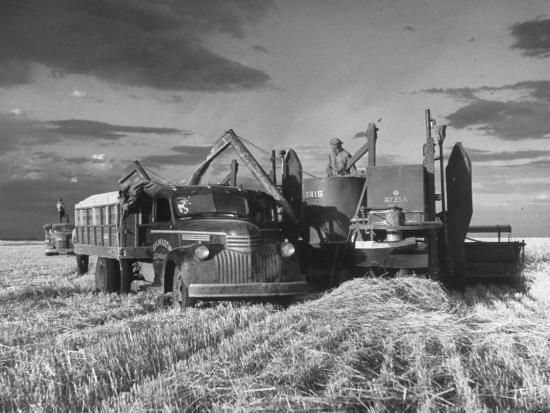
In our own granary during the winter we would mill some of the grain and feed it to the yearling calves.
Our Milling Machine (the old giant motor with long belt is not shown)

After the grain crop is in the only tasks to be done are to prepare for the very cold winter coming. This means shutting off outside water, winterizing anything with a motor, preparing the water troughs which will be freezing over and need to be thawed each day. At this point the calves, cows, and bulls are still out on The Divide range. As the nights get colder the horses and cattle begin to grow long coats of hair and begin to look shaggy.
As soon as the snow lays on the ground in enough depth to cover the grass it is time to ride the horses out to The Divide and round up the cattle and bring them in to the farm for the winter. Unfortunately in a year of little snow this sometimes meant the day after Christmas, a real bummer. A leather saddle in 10-15° weather is not that warm, especially if the wind was blowing. The cattle would be scattered all over the landscape and down in each draw of Devils Gulch canyon so you had to ride each draw in search of them. When the cattle were finally at the ranch the daily routine of feeding them would commence once again.
And now we are back to the beginning of this narrative. This has been the yearly cycle of ranching and farming we experienced in Wallowa County from 1946 to 1964.
End of Narrative